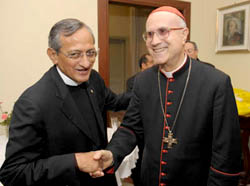(ANS – Vatican City, 14th Oct 2008) – The contribution Fr Pascual Chávez, Rector Major of the Salesians, made on Saturday 11 October, at the XII Ordinary General Assembly of the Synod of Bishops - "The Word of God in the Life and Mission of the Church," the subject chosen by the Holy Father for this Synod when he called it on 6 October 2006 - was marked by its reference to the young.
Referring to number 53 of the Instrumentum laboris (IL) fo r the Synod – “Everyone should have access to the Word of God at all times” and focusing on “especially among the young” as the text proposes, the Rector Major used as the starting point the Gospel episode of Emmaus, “an exemplary model of the believer’s encounter with the Incarnate Word” (IL 26b). “The episode, chronicle of a past event, offers us a precise itinerary of evangelisation where it is said who, Jesus by means of His word, and how, walking together, to evangelise ,” the Rector Major said.
r the Synod – “Everyone should have access to the Word of God at all times” and focusing on “especially among the young” as the text proposes, the Rector Major used as the starting point the Gospel episode of Emmaus, “an exemplary model of the believer’s encounter with the Incarnate Word” (IL 26b). “The episode, chronicle of a past event, offers us a precise itinerary of evangelisation where it is said who, Jesus by means of His word, and how, walking together, to evangelise ,” the Rector Major said.
Referring to some of the statements of the 21 and 23 General Chapters of the Salesians, Fr Chávez recalled that if “’the life of communion with God and with one’s brothers and sisters is the aim of the proclamation of the Gospel,’ then ‘for evangelisation the witness of a life in common in decisive, since it is an experience which anticipates, like a seed what is to come.’ If ‘witness is the only language capable of convincing the young that ‘God exists and that his love can fill a life completely’ (Salesian Constitutions 62), evangelisation ought to take as its strategic option, and ‘concentrate attention and effort’ on’ the ’unity of and in the Church, which is the evangelical sign that Jesus asks of the disciples he sends into the world.’ ‘One has to have serious doubts therefore about an
 evangelisation, whatever may be its methods and without questioning its good intentions, which does not start from a life in common.‘ Even though we have to recognise that ‘young peoples’ belonging to the Church does not reach maturity immediately,’ the Rector Major said – “We have to say that if they do not live their lives in her, the faith of the evangelisers and that of the young people would be deficient.’
evangelisation, whatever may be its methods and without questioning its good intentions, which does not start from a life in common.‘ Even though we have to recognise that ‘young peoples’ belonging to the Church does not reach maturity immediately,’ the Rector Major said – “We have to say that if they do not live their lives in her, the faith of the evangelisers and that of the young people would be deficient.’
The passage about Emmaus also offers a method for the evangelisation of the young: walking side by side. The frustration of their dreams, the fatigue in their faith and the disenchantment in discipleship are experiences the young share with the disciples on the way to Emmaus. “The young need a Church which is close to their problems and their worries, which not only shares their journey and their fatigue, but also knows how to talk to them, accepting their uncertainties. How can the Church represent the risen Lord, if it does not appear to be concerned about them and their lives? ‘Going to met the young where they are to be found, welcoming them with disinterested concern, listening carefully to their questions and their aspirations are for us fundamental steps they come before any other stage of education to the faith’ (GC 23, 98)”.
The Emmaus story – model of the spiritual biography of the young – reminds us that “An education to the faith which forgets or postpones the sacramental encounter of young people with Christ, is not a secure, efficient way to find Him.” The Mass is and ought to remain, ‘the source and summit of evangelisation’. The eucharist is the ‘source and the summit of Christian life.” Fr Chávez declares: “It is a false excuse to say that not all young people are sufficiently well prepared to celebrate a meeting with Christ: since meeting him has never been the result of their efforts, not even the fulfilment of their desires, but the grace of Christ, who comes to meet those whom he loves. Were the disciples of Emmaus well prepared to discover the Lord in the stranger, their travelling companion?”
Fr Chávez declares: “It is a false excuse to say that not all young people are sufficiently well prepared to celebrate a meeting with Christ: since meeting him has never been the result of their efforts, not even the fulfilment of their desires, but the grace of Christ, who comes to meet those whom he loves. Were the disciples of Emmaus well prepared to discover the Lord in the stranger, their travelling companion?”
Quoting number 93 of the GC 23, the Rector Major concluded his intervention saying: “All this we do in imitation of the Lord and following the way of his love on the road to Emmaus. We reproduce his attitudes: we take the first step in approaching the young and we join them; we travel with them along the same road, listening to them, a sharing their hopes and anxieties; we patiently explain to them the demanding message of the gospel; and we stay with them to repeat the gesture of breaking the bread and stir up in them the ardour of faith.”